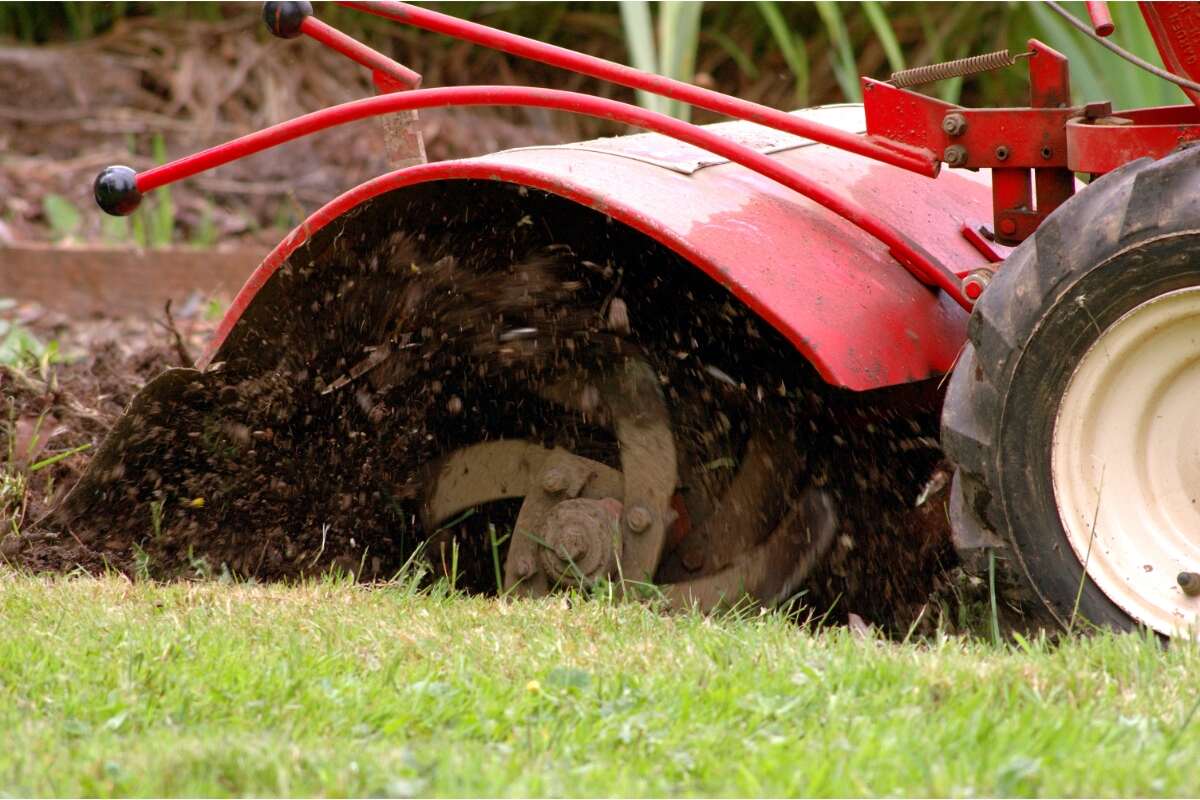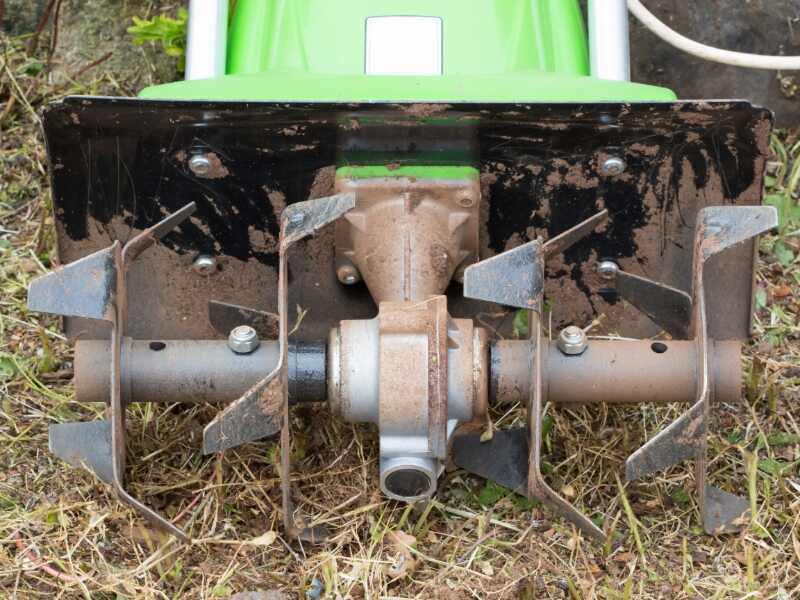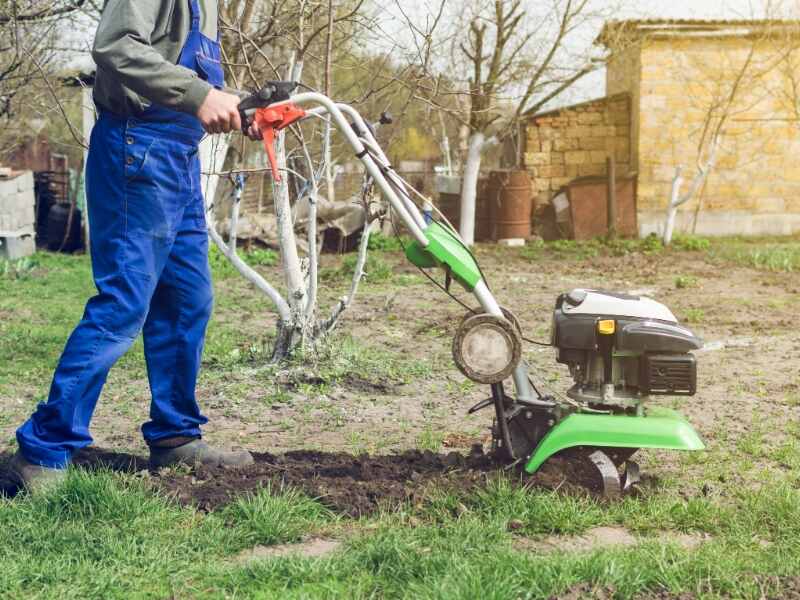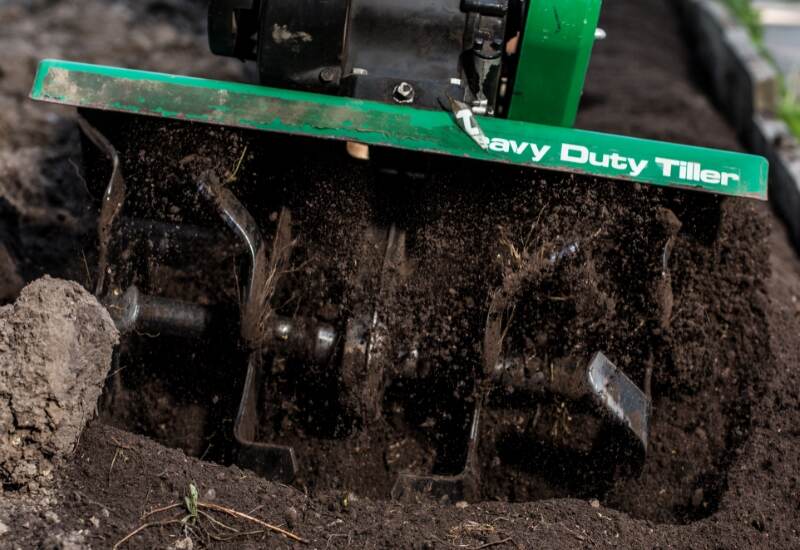
Pulling up a lawn to reseed is a daunting task requiring labor and sweat. A sod cutter is a great way to remove the grass, but a grass tiller is even better because it gets down under the root system. To help make the process easier, we’ve put together everything you need to know about how to use a grass tiller to remove an existing lawn and transform your landscape.
What is a Tiller and How Does it Work?

A tiller — often known as a garden tiller or a rototiller — is a powerful piece of equipment for breaking up hard soil and mixing it into a loose, crumbly bed that is ready for planting. An electric or gas-powered engine rotates large steel blades known as tines to shear through the soil quickly.
Garden tillers make quick work of grass removal, cutting the time spent prepping to a fraction of what it would take to do it by hand. On average, you can prep about 1,000 square feet of soil in about 2 hours using a motorized tiller.
If using a tiller doesn’t sound like your ideal way to spend a Saturday, hire a local landscaping pro to tackle your tilling job instead.
How to Use a Grass Tiller
A tiller is a handy way to remove grass from a lawn to prepare an area for reseeding or create a garden, patio, or play area. Unlike a sod cutter, a tiller can get deeper into the ground, under the roots, to prevent grass from regrowing.
Like any DIY project, plan before you start. Here are easy step-by-step instructions to use a grass tiller to remove your lawn.
Locate Underground Utilities
Before starting this project, call 811 and have someone come out and mark underground utility lines.
Clean the Area
A tiller is a powerful machine, but it isn’t invincible. Walk through the area you’re going to till and remove debris, branches, rocks, metal, kids’ toys, dog bones, etc. All of these items can damage the tiller’s blades, plus they pose a significant hazard to you if the blades fling an object into the air.
A heavy-duty tiller can work through some materials like smaller sticks, but it’s best to be safe and remove as much debris as possible.
Mow Short
A common error people make when using a tiller is leaving the grass (and weeds) long, thinking their tiller will power through everything. You can certainly start working the area with the grass knee-high, but the tines on your machine will become clogged in seconds. You’ll find yourself constantly shutting everything down to pull weeds and long grass out of the tines and from around the axle.
Take a few minutes and mow your lawn short — don’t be afraid to scalp your grass. Or you can use your handy-dandy weed burner to burn all the foliage to the ground. Just be careful with the flame and keep a garden hose close.
Mark Sprinkler Heads and Lines
Since you’ll be working across your entire yard, use landscaping flags to map out your sprinkler heads to avoid hitting them with the tiller. Turn the sprinkler system on one zone at a time and walk through your yard, setting flags at each head.
It’s also helpful to mark out the sprinkler lines if you know where they are. Lines are usually buried beneath the frost line in the ground, so they’re typically 10 to 12 inches beneath the surface. Mark the lines with spray paint. When operating the tiller, avoid the lines or raise the depth.
Moisten the Ground
Ideally, you want the ground to be slightly moist without being soggy or waterlogged. If the soil is too dry, it will be hard to work, and the tiller will jerk and bounce around—putting much more strain on your back, shoulders, and arms. On the flip side, if the soil is too wet, you’ll be slopping through mud, creating a huge mess and even running the risk of compacting the soil.
Water your lawn a day or two before tilling. The goal is to soften the ground so the tiller blades move through the soil easily, breaking up clods and mixing the soil well.
Wear Protective Gear
Making sure you’re safe while working is important. A tiller is a dangerous piece of power equipment. Wear closed-toed shoes, full-length pants, safety glasses, and hearing protection.
Pro Tip: If you have long hair, tie it back.
Start the Tiller
Be sure to follow the operating instructions for your model. Here are a few basic steps for operation:
- Switching the engine to “on.”
- Open the throttle to allow fuel to move into the engine.
- Engage the choke to let a richer fuel mixture into the engine, making it easier to start.
- Locate the recoil pull cord on the engine, grab the handle, and pull it swiftly towards you in one, smooth motion.
- If the engine doesn’t start on the first pull, let the recoil pull cord retract and try again.
- As soon as the engine fires up, disengage the choke.
Adjust the Tiller Tines
Before digging in, set the adjustable tiller depth so the blades are just below the roots and the grass comes up completely.
Press the clutch lever on the tiller and allow the blades to dig into the soil until you’re satisfied with the depth. Then, adjust the depth setting to keep the machine from digging deeper.
Work in Straight Lines
With the tiller set to the proper depth, engage the drive and slowly push the machine forward, letting it dig the soil. Let the wheels pull the tiller along, taking advantage of the movement of the blades.
Work in straight, parallel lines from one side of your lawn to the other. When you reach the end of a row, carefully move the machine in a curving motion to turn it around.
Each time you turn and start a new row, ensure there is no gap from the previous row. The easiest way to do this is to overlap the new line with the one you just tilled.
Once you’ve worked the entire area in one direction, it’s a good idea to switch and till everything in a perpendicular pattern to ensure you’ve mixed the soil well.
See Related:
Tips for Operating a Tiller

Follow a few simple tips to get the most out of your lawn tiller:
- Read the tiller’s operating manual before you use it. Each model is different, and it’s essential to familiarize yourself with the equipment to ensure you’re operating it correctly.
- Exercise caution when tilling. If the tines catch on something and propel the tiller forward, let go of the handlebars, allowing the clutch lever to disengage.
- If you strike something, let go of the clutch lever and kill the engine. Disconnect the spark plug ignition wire and inspect the tiller for damage before continuing.
- Avoid pushing down on the handlebars to force the tiller deeper into the soil. Let the weight and force of the machine work the blades into the ground.
- Never put your hands or feet near the rotating blades.
What to Look For in a Tiller
When shopping for a new grass tiller, consider the following features to help guide your decision:
Size
The most important aspect to consider is the size. This is not a time when bigger is better—a tiller is strenuous to operate. Only buy the size you need for the job.
Tillers are available as mini-tillers (also known as cultivators), mid-sized, and large tillers.
- Mini-tillers or garden cultivators are best for small areas like a vegetable garden. These lightweight, compact machines generally cost $100 to $450 and have a width of up to 10 inches, making them ideal for tight spaces.
- Mid-sized tillers have tines in front of the wheels and can cost upwards of $600 or more. These front tine tillers have a tilling width of around 14 inches.
- Large grass tillers are a workhorse. Their wheels sit in front of the blades and can till up to 21 inches. These rear tine tillers are fantastic for working compacted soil but can cost as much as $3,000.
Engine Type
Garden tillers are similar to lawnmowers in that the engines are either gas-powered or electric. Most run on gas because the engine needs enough horsepower to push the blades through the soil.
A cordless tiller serves a useful purpose, but a battery-powered model might not be powerful enough to remove an existing lawn. If you’re looking at an electric tiller, make sure it is at least 13.5 amps.
Tillers typically have pull-start like push mowers. However, some larger, more expensive models come equipped with electric starters.
Pro Tip: When purchasing a gas-powered tiller, note whether the engine is a 2-cycle or 4-cycle. A 2 cycle engine is cheaper, but it has less torque. You’ll need to use a blend of gas and oil to operate it. A 4-cycle engine is larger with more torque and has a separate gas and oil reservoir, but it is usually more expensive and has higher maintenance requirements.
See Related:
Tine Rotation
Lastly, look at how the tines rotate on the machine. Tillers come with forward rotation blades or reverse rotation, also known as counter-rotation tines.
- Forward-rotating tines rotate forward on the axle shaft in the same direction the tiller is moving. They won’t work as deeply into the soil but tend to give a finer texture.
- Reverse rotating tines move counter-clockwise to the direction the tiller is moving. They take more horsepower to run and result in a coarser texture of soil. However, they dig more aggressively, working deeper into the ground.
Where to Buy a Tiller
You can find grass tillers at your local home improvement stores such as Home Depot, Lowe’s, or Menards. Just look for places that sell garden tools or power tools.
Common, reputable brands include:
- Honda
- Toro
- Troy-Bilt
- Mantis
Pro Tip: If you’re not in the position to purchase a tiller, many places offer rental options.
Other Ways to Use a Grass Tiller

Having a tiller can be beneficial for reasons other than removing a lawn. Many gardeners use it in the following ways:
- Prepare garden soil or flower beds for planting
- Weed between vegetable garden rows during the growing season
- Work soil amendments like compost or fertilizer into the soil
See Related: How to Fertilize Your Lawn
FAQ About Using a Grass Tiller
The most common way to remove dead grass after tilling is to rake or hoe the area, pull up the dead grass, and then dispose of it. You can also use a weed burner to burn off the remaining grass and roots.
If you don’t get the entire root system when you use a grass tiller, the grass may grow back, depending on the turfgrass cultivar in your lawn. If it regenerates from the root system, it can sprout again. For example, Bermudagrass readily sprouts from the roots, and even small root sections may result in grass returning.
The most common way to get rid of a lawn is to use a sod cutter. You can also smother the entire lawn with cardboard (called sheet mulching) or plastic or use herbicides to kill the grass.
Professional Services
Purchasing a tiller is a financial investment, and using it to remove your entire lawn is a challenging DIY task. If you’re intimidated by the project and need some help, let LawnStarter connect you with a local lawn care company or landscaping pros. They will remove your existing lawn and reseed it, giving you the yard of your dreams.
LawnStarter participates in the Amazon Services LLC Associates Program and other retailer affiliate programs. LawnStarter may earn revenue from products promoted in this article.
Main Photo Credit: jurden / Canva Pro / License